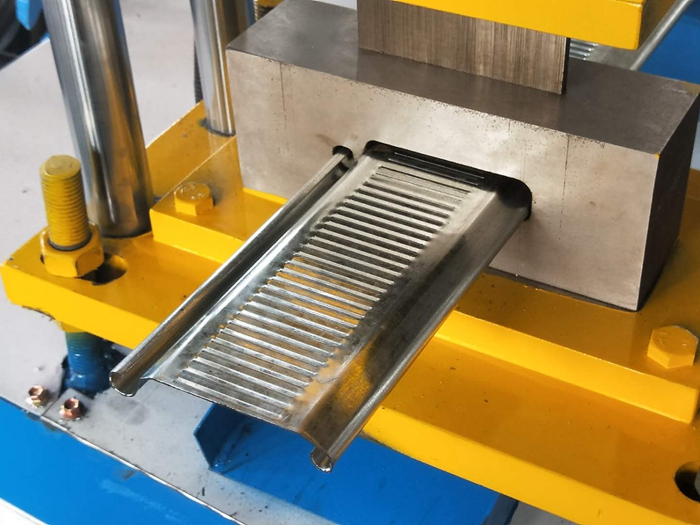slat roll forming machine
Understanding Slat Roll Forming Machines A Comprehensive Overview
In the modern manufacturing landscape, precision and efficiency are paramount. One of the key technologies that facilitate the production of high-quality metal components is the slat roll forming machine. This piece of equipment is designed to produce slats used predominantly in various industries, including construction, automotive, and manufacturing. This article delves into the workings, applications, benefits, and features of slat roll forming machines.
What is a Slat Roll Forming Machine?
A slat roll forming machine is a specialized piece of machinery that continuously transforms flat metal sheets, typically made of steel or aluminum, into intricate shapes, known as slats. Slats are versatile components used in many applications, including fences, gates, and various types of partitions. The roll forming process involves feeding metal sheets through a series of rollers that gradually shape the material into the desired profile without cutting or welding, thus ensuring minimal material wastage.
The Roll Forming Process
The roll forming process starts with the preparation of raw materials, usually in the form of coiled sheet metal. The sheet is unwound and fed into the machine, where it passes through a series of rollers. Each set of rollers is designed to perform a specific function, gradually bending and shaping the sheet into the final slat profile.
The machine operates at a high speed, and the continuous rolling process allows for the production of long lengths of slats. Once the desired length is achieved, the slats are cut to size using a shearing mechanism. The entire process is automated, which not only speeds up production but also ensures a high level of consistency and precision in the final product.
Applications of Slats
Slats produced by roll forming machines have a wide array of applications. They are commonly used in
1. Fences and Gates Slats provide security and privacy in residential and commercial properties. They can be designed for aesthetic appeal while maintaining functionality.
2. Indoor and Outdoor Partitions Slats are often used to create partitions in offices, homes, and public spaces, providing both separation and visual interest.
3. Automotive Components In the automotive industry, slats can be used in various parts, enhancing structural integrity while contributing to lightweight design requirements.
4. Grilles and Louvers Slat designs are commonly found in grilles and louvers for ventilation systems, as they allow airflow while providing a level of protection and privacy.
Benefits of Using Slat Roll Forming Machines
slat roll forming machine

The advantages of using slat roll forming machines are numerous
- Efficiency These machines are capable of producing high quantities of slats in a short period, significantly reducing production lead times.
- Material Savings The roll forming process minimizes waste, as it uses the full width of the metal sheets without cutting additional segments.
- Versatility Slat roll forming machines can accommodate various material types and thicknesses, allowing manufacturers to produce a broad range of products.
- Consistency Automated roll forming equipment ensures uniformity in the size and shape of each product, which is crucial for applications requiring tight tolerances.
- Durability The slats produced are typically strong and robust, capable of withstanding environmental stressors and handling.
Key Features of Slat Roll Forming Machines
When considering a slat roll forming machine, certain features are crucial
- Roll Design The quality and design of the rollers directly impact the efficiency and accuracy of the shaping process.
- Control Systems Advanced control systems, including PLC (Programmable Logic Controller), enhance automation and precision.
- Cutting Mechanism A reliable cutting system ensures that slats are cut to the required lengths without damaging the finished product.
- Modularity The ability to adjust the machine settings for different profiles or materials can enhance flexibility in production.
Conclusion
In conclusion, slat roll forming machines play a vital role in modern manufacturing by producing high-quality, versatile components used across various industries. Their efficiency, precision, and durability make them an essential investment for companies looking to enhance their production capabilities. As technology continues to advance, the capabilities of slat roll forming machines will undoubtedly expand, paving the way for even more innovative applications in the future.
-
Roof Panel Machines: Buying Guide, Types, and PricingNewsJul.04, 2025
-
Purlin Machines: Types, Features, and Pricing GuideNewsJul.04, 2025
-
Metal Embossing Machines: Types, Applications, and Buying GuideNewsJul.04, 2025
-
Gutter Machines: Features, Types, and Cost BreakdownNewsJul.04, 2025
-
Cut to Length Line: Overview, Equipment, and Buying GuideNewsJul.04, 2025
-
Auto Stacker: Features, Applications, and Cost BreakdownNewsJul.04, 2025
-
Top Drywall Profile Machine Models for SaleNewsJun.05, 2025








